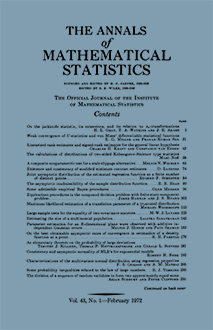Abstract
Given a sequence $\{X_n; n \geqq 0\}$ of random variables, let $\{P^\theta; \theta \in \pi\}$ be a parameterized class of probability measures, with respect to each of which the sequence is a Markov chain. Under conditions which make it appropriate to define likelihood ratios, the parameter set $\pi$ can be identified with a subset of the Martin boundary for the space-time chain $\{(n, X_n); n \geqq 0\}$, so that each parameter $\theta$ can also be considered as a point of this Martin boundary. Then for each $\theta$, the spacetime sample paths converge in the Martin boundary topology to $\theta$, almost surely with respect to the probability measure $P^\theta$. Moreover, the likelihood ratio corresponding to the parameter $\theta$ is the same as the minimal regular function corresponding to the parameter $\theta$, and the probability measure $P^\theta$ is the relativised probability measure corresponding to the point $\theta$.
Citation
Allan F. Abrahamse. "A Comparison Between the Martin Boundary Theory and the Theory of Likelihood Ratios." Ann. Math. Statist. 41 (3) 1064 - 1067, June, 1970. https://doi.org/10.1214/aoms/1177696982
Information





